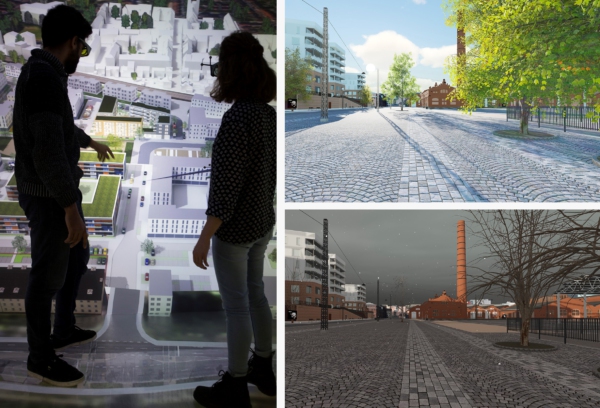Green Twins – bringing together public space, greenery and people thorugh a digital twin
Urban green spaces are particularly important due to urbanization and anthropogenic climate change. Urban greening affects the physical and mental health of citizens. This reduces the direct effects of global warming, such as heat islands, and improves the thermal comfort of cities. In addition, plants affect particulate emissions and the carbon balance. Urban landscaping is an important part of the city's cultural heritage and identity.
As part of the Smart City Center of Excellence, the GreenTwins project deals with the issue of urban greening and how to better take the urban natural environment into account in urban planning processes. The focus is on digital twins of the city: they can be used to enable comprehensive data exchange and can contain models, simulations and algorithms that describe the actual urban environment, its characteristics and behavior in the real world. Digital twins have entered urban planning only in recent years. Singapore’s digital twin is certainly one of the best known example. The cities of Tallinn and Helsinki are consistently building their own digital twins to digitize and optimize planning processes, while Estonia’s national-level digital twin was only recently presented.
The modeling of the natural environment in the digital twins has so far been underdeveloped compared to the built environment modelling. Also, little attention has been paid to participation and cooperation processes in the implementation of digital twins. Yet these digital tools offer great opportunities. The GreenTwins project develops a dynamic layer of green infrastructure in the digital twins of the cities of Helsinki and Tallinn. In addition, three new user interfaces for the digital twins have been created to exploit the potential of digital twins in promoting planning processes and democratic decision-making. Accurate modeling of the natural environment is essential for citizen participation, as non-professional stakeholders often lack the necessary knowledge or professional background. Because of this barrier, many people are left out of participatory processes or have problems interpreting professional plans correctly.
This is where GreenTwins comes to the rescue, during which an outstanding team of scientists and experts from the partner cities of Tallinn and Helsinki developed new solutions. CityHUB, or Tallinn’s permanent virtual center for inclusive urban planning, has been developed to serve citizens, planners, decision-makers, city governments, companies and researchers. In addition, two applications have been developed within the project. The co-planning application provides additional information and the opportunity for citizens to participate directly in the planning process. The city simulation application enables a virtual space experience in CityHUB, but also on desktop computers. For the first time, an inventory of existing species and their characteristics have been added to the digital twin as a dynamic digital layer. The focus was on the interaction between the built and natural environment, plants’ seasonal and over time changes. The impact of vegetation on our neighborhood and cityscape, urban space and microclimate, as well as our well-being is visualized. Visualization and engagement can reduce the complexity of urban planning and enable and encourage more democratic participation and citizen science.
The GreenTwins project contributes to the development of participatory urban planning, which is related to one of the global sustainable development goals established by the United Nations (SDG 11). The continued development of cities’ digital twins creates new opportunities for better citizen engagement and improved democratic processes in civil society.
The GreenTwins smart city pilotproject was funded by the European Union’s Regional Development Fund and Estonian Ministry of Education and Research.

